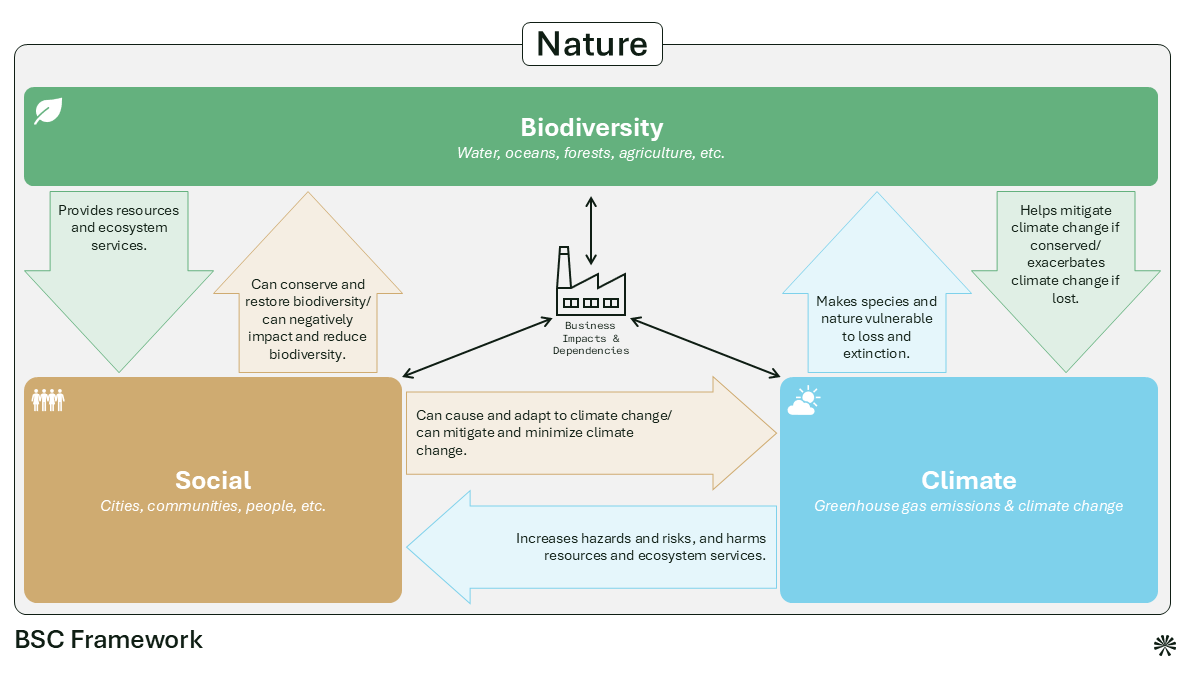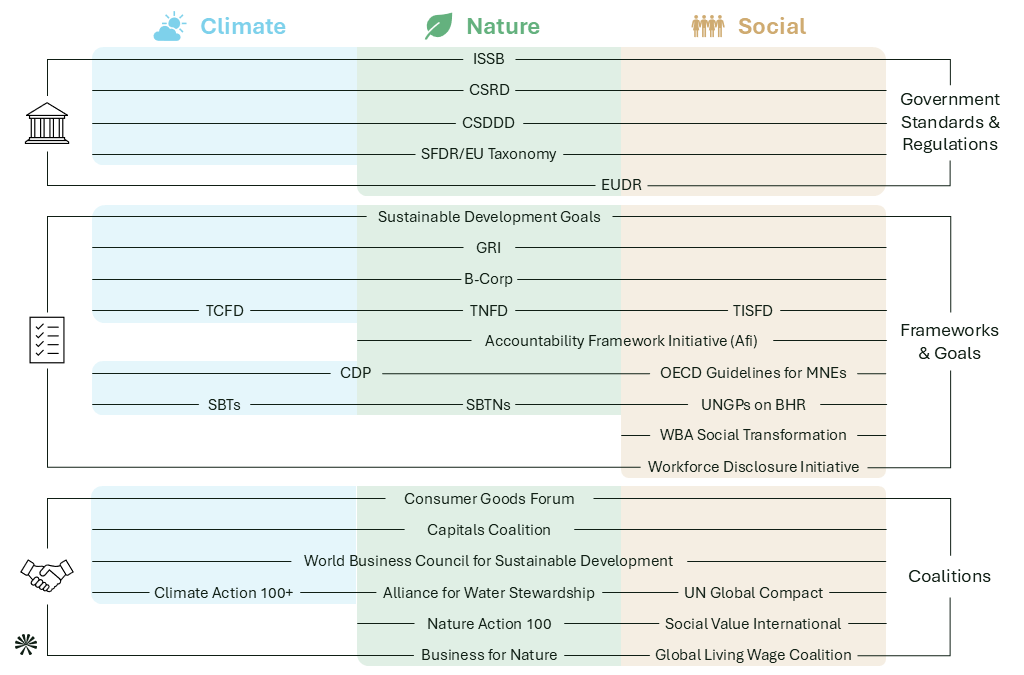
Table of Contents
- Decarbonisation
- Nature & Biodiversity
- Social Impact
- Regulations & Frameworks
- BSC Roadmap
- First Mover Advantage
- How Anthesis Can Help
Share this article
This article was written by Hope Bristow, Claire Bosch Zuazo, Vanessa Celis Gil, Alexa Cotton, Viviana M. Jiménez, Courtney McCorstin, and Karen Hamilton.
Carbon emissions are often used as a baseline for measuring anthropogenic impact on planetary systems. This solitary focus on carbon unfortunately comes with trade-offs that can have adverse effects on natural ecosystems and local communities, undermining the very core of what sustainability seeks to address. Increasingly, companies and stakeholders are recognising the need to integrate biodiversity and social considerations into strategies, plans, and practices, alongside climate and decarbonisation goals.
The climate is just one critical component of our life-sustaining web. Equally important are an abundance of diverse species, access to clean air and water, equity, and justice. Organisations across all sectors are now seeking best practices to baseline, measure, and minimise negative impacts across climate, biodiversity, and social aspects of their operations.
In this article and our conceptual framework (Figure 1) below, we describe the importance of an approach that integrates biodiversity, climate, and social considerations into corporate sustainability strategies.

Decarbonisation
The Earth’s temperature has increased by about 1.1°C since 1850 and the rate of warming has accelerated since the 1980s. In fact, the warmest year on record was 2023 at 1.35°C above pre-industrial levels. Unfortunately, 2024 appears to become a new record-breaker.
Under the Paris Agreement, 192 countries adopted a bold goal to minimise catastrophic impacts of climate change by reduce greenhouse-gas (GHG) emissions enough to limit the rise of global temperatures in the 21st century to “well below 2°C above preindustrial levels” while working to limit global warming to 1.5 degrees Celsius. Similarly, regulatory bodies worldwide increasingly aim to ensure companies are resilient to climate change, aiding long-term investment decisions and strategic planning.
The Risks & Opportunities of Climate Change
Find out why businesses need to understand and mitigate climate risks.
For these reasons and more, decarbonisation has become a key priority in mitigating climate change and reducing greenhouse gas (GHG) emissions from the atmosphere.
Nature & Biodiversity
Ecosystem services (natural capital) play a crucial role in the global economy and the operations of companies. Healthy ecosystems provide essential services, such as crop pollination, water regulation, and protection against natural disasters, all of which are essential provisioning services for many industries. In turn, biodiversity contributes directly to food security and the supply of natural resources, resulting in a reduction of risks and costs for companies that depend on these resources.
Biodiversity is also a vital indicator of the state of life on our planet. The main factors that contribute to biodiversity loss include pollution, habitat destruction, climate change, the presence of invasive species, and the overexploitation of natural resources.
According to the 2024 Living Planet report, the size of monitored wildlife populations (mammals, birds, reptiles, amphibians, and fish) has declined by 73% since 1970. The main driver of biodiversity loss remains humans’ use of land, though climate change is increasingly contributing to the decline of life on the planet.
Beyond sustaining life, biodiversity is also essential for climate change mitigation. Land and ocean ecosystems – and the biodiversity they contain – are natural carbon sinks, providing nature-based solutions to climate change.
For companies, biodiversity loss and the associated drivers of ecosystem degradation, such as pollution, habitat destruction, climate change, the introduction of invasive species, and the overexploitation of natural resources can affect the stability and sustainability of business operations in the long term. The reduced availability of key resources ultimately leads to increases in operating costs.
Social Impact
The International Labour Organisation (ILO) emphasises the importance of decent work and social protection as integral to a just transition. Similarly, the United Nations stresses the need to respect human rights and involve local communities in decision-making processes to avoid displacement and loss of livelihoods, and the OECD outlines responsible business expectations.
Nearly 50 governments have formally committed to developing just transition policies, and more than 19 governments have established national transition task forces or commissions.
There is also a growing recognition from the private sector of the importance of aligning with a just transition.
When greening the economy towards a net-zero context, we will need to transition from an extractive economy, where there is unsustainable extraction of planetary resources, to a regenerative economy, where principles of cooperation, ecological, and social wellbeing are prioritised.
This is the premise of a just transition: to maximise the social and economic opportunities of climate action, while carefully managing challenges and minimizing harmful impacts. These include respect for fundamental labor principles and rights, creating decent work, effective social dialogue, and leaving no one behind.
Adhering to just transition principles and principles of climate justice provides a clear path forward for business leaders and coalition builders to center equity and justice as part of their climate actions. Companies that adopt just transition frameworks are better positioned to navigate social risks with place-based stakeholders such as workers and communities, reduce reputational damage, and can better anticipate the physical, transitional, and adaptation measures necessary for their own operations and their supply chains, thereby reducing the number of shocks and stresses within their manageable control.
Regulations & Frameworks
Current regulations and frameworks are increasingly concerned with an integrated approach to sustainability, requiring organisations to understand the impacts their operations and value chains have on the climate, on nature and biodiversity, and on society.
At the multi-state level, regulatory processes have been led by key developments in the European Union, and there is a growing trend globally towards assessing and reporting on risks, opportunities, and impacts beyond climate and carbon, with more regulations, frameworks, coalitions, and goals that seek to integrate nature, social, and climate considerations (Figure 2).

Biodiversity, Social, and Climate (BSC): Roadmap and Action Plan
The growing number of countries, sub-national entities, and organisations that have made climate net-zero pledges demonstrates the power and unifying force of these frameworks and regulations. As these stakeholders continue to recognise that altering biodiversity puts human livelihood and organisational operations at risk, we can expect more guidance and regulations to come.
Organisational sustainability strategies already integrate important social and governance issues across the entire lifecycle of their products and services, which are foundational to a beyond-net-zero world. For example, human rights, compliance, community impact, and employee diversity are critical components of many sustainability strategies. Increasingly, however, organisations have begun to assess how to integrate biodiversity, nature, the needs and views of the local communities in which they operate, and equity aspects into their operational strategies and processes. In fact, the need for an ‘equitable net-zero transition that leads to socio-ecological balance and broad economic opportunities for all’ (The meaning of net zero and how to get it right) is now presented as key to climate transition planning.
Anthesis’ BSC Roadmap (Figure 3) focuses on:

1. Assess Risks and Opportunities
The first step in creating a mid- to long-term roadmap and a short-term action plan with integrated climate, nature, and social aspects, is to assess risks, gaps, and opportunities. This allows organisations to understand which issues are critical to their operations and stakeholders, the potential costs of failure to address them, and opportunities for increased value.
The Taskforce on Nature-Related Financial Disclosures (TNFD) has developed an approach for organizations to integrate nature considerations into decision making by identifying an organization’s nature impacts, dependencies, and risks and opportunities. This approach, LEAP, involves locating your interface with nature, evaluating your impacts and dependencies on nature, assessing your nature-related risks and opportunities, and preparing to respond and report.
The TNFD encourages companies to disclose their impacts and dependences on nature, as well as the measures they are taking to address these issues. By providing investors with reliable data on how companies are assessing and managing nature risks and opportunities, the TNFD enables capital flow towards companies that prioritise positive environmental outcomes.
Similarly, the Taskforce on Inequality and Social-related Financial Disclosures (TISFD) aims to approach social and inequality-related issues in an integrated and coherent manner that reflects the breadth of issues concerned with and the correlations between companies’ responsibility to respect human rights, efforts to reduce inequalities and enhance people’s well-being, and investments in human and social capital. The goal of the TISFD is to increase companies’ and financial institutions’ understanding of their impacts and dependencies on people, and strengthen their identification, measurement, management, and disclosure of inequality and social-related impacts and the associated financial risks and opportunities.
By using these key frameworks, we can identify priority risks and opportunities for your company to begin to identify key focus areas for the roadmap.
2. Prioritize Initiatives
Once risks and opportunities have been identified, the next step is to identify and frame a set of high-level initiatives and goals that can deliver the most business value, minimise risks, improve sustainability performance, and improve positive (or minimise negative) impacts.
At this point in the process, we integrate the company’s GHG emissions and key carbon hotspots into the roadmap development to determine key decarbonisation opportunities informed by natural and social impacts.
3. Design BSC Roadmap
Building off the analysis, we support the development of a mid- to long-term tangible roadmap and a short-term action plan to help implement and reach sustainability targets and priorities.
Throughout the process, and to activate change management within your organization to implement the BSC Roadmap, we engage key stakeholders to gather insights on priority areas, strategic interests, feasibility considerations, ownership of action steps, and governance.
First Mover Advantage
Throughout your sustainability journey, planning for impact beyond decarbonisation can place your organisation in a leadership role and minimise future risk related to climate, nature, and social impact. Since these risks are interconnected, a holistic approach reduces the likelihood of a company’s progress in one area at the expense of increased impact to another. This will also minimise material financial, regulatory, physical, and systemic risks and costs, and increase any value from opportunities that arise.
Proactively preparing for a world that lives within planetary boundaries gives your organisation a voice in the development of industry standards and best practices. Proactive companies which can operate through an integrated BSC lens have the strongest probability of creating value for all stakeholders (the planet, local communities, customers, and shareholders). Reactive companies, on the other hand, face the risk of increased costs and risks, as well as decreased brand reputation from being late adopters.
How Anthesis Can Help
Climate, biodiversity and nature, and social impacts, risks, and opportunities are inherently interlinked through and beyond our changing climate. Achieving “net-zero” requires thinking of and investing in nature-based solutions, and understanding your company’s impact on communities and people is an effective way to bring stakeholders along. The most practical and efficient way to build a BSC Roadmap is through an integrated development process rather than retroactively fitting separate climate, nature, and social approaches together.
Increasingly, regulations ask companies to speak to and demonstrate real action through how their governance, strategy, risk management, and tracking of metrics & targets effectively mitigates risk and takes advantage of opportunities in the realm of sustainability. Considering all components at the outset of creating a corporate strategy will help companies prepare to respond and avoid the risk of implementation gaps.
Anthesis’ global expertise and range of sustainability services can support your company in the creation of a BSC Roadmap to transform the impact of your sustainability strategy. Change management and business transformation across relevant business functions will be critical, and successfully implementing this transformation will put your company on a pathway to compete and lead in a sustainable world.
We are the world’s leading purpose driven, digitally enabled, science-based activator. And always welcome inquiries and partnerships to drive positive change together.



